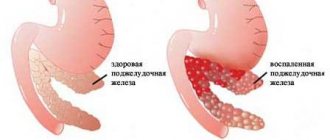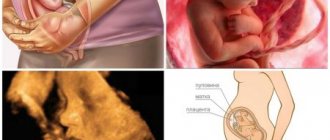The 35th week of pregnancy has arrived. The baby is the same number of weeks old - he has formed and grown in the womb, and already has unique facial features. He has grown by about three centimeters, gained a little weight and his weight is now about 2.4 kilograms.
Pregnancy is slowly approaching its logical conclusion
What is a child falling
"Baby Falls" may sound shocking if you're not familiar with it. After all, everyone knows that you shouldn’t abandon a child.
In the context of pregnancy, it is a natural phenomenon that occurs at the end of the third trimester and signals that the baby is preparing for birth. How to understand that the belly has dropped during pregnancy: “Fall” means that the baby’s head drops lower into the pelvis and is set in the position necessary to move along the birth canal.
When the belly drops during pregnancy, the baby takes up less space in the upper torso and puts less compression on internal organs such as the lungs and abdomen. For this reason, you will likely be able to breathe easier and eat more comfortably after your baby falls.
Because of this sensation, a child's fall is also called lightning. Your baby will likely not have noticeable symptoms, especially if it happens gradually. How to tell whether your stomach has dropped or not by Lightning is something that you tend to notice after the fact, and immediately after that you realize that it has already happened.
The belly has dropped photo in the picture:
Weight gain
What a woman’s body weight gain should be at different periods can be seen in the table.
| Gestational age | Weight gain in women, depending on BMI | ||||
| BMI less than 18.5 | BMI from 18.5 | BMI from 25 to 30 | BMI from 30 | Multiple pregnancy | |
| 1.17 | 3,25 | 2,35 | 2,25 | 1,50 | 4,55 |
| 17-23 | 1,77 | 1,55 | 1,23 | 0,75 | 2,70 |
| 23-27 | 2,10 | 1,95 | 1,85 | 1,3 | 3,00 |
| 27-31 | 2,35 | 2,11 | 1,55 | 0,65 | 2,35 |
| 31-35 | 2,35 | 2,11 | 1,55 | 0,65 | 2,35 |
| 35-40 | 1,75 | 1,25 | 1,55 | 0,45 | 1,55 |
| Increase for the entire period | 12,5-18 | 11,5-1 | 7-11,5 | 6 or less | 16-21 |
You might be interested in: Why there is no birth at 43 weeks of pregnancy
If a mother is gaining weight too quickly, she should think about adjusting her diet. You may need to exclude too many carbohydrates and fatty foods from the menu, and do gymnastics.
What happens when my baby goes down
In early pregnancy, your baby has plenty of room to move around. They regularly twist, turn and flip over.
As your child grows, he or she becomes increasingly short on space. You can still feel that they are extremely active - kicking, stretching and even spinning. However, as your baby gets bigger and bigger, he will begin to leave the "room" to move around. Limited to the chest, internal organs and the uterus itself.
At some point, how long before birth, the belly drops. Towards the end of your pregnancy, your baby will stand up and stay in place. Ideally, this will be with your head down, facing your back.
How to tell if your belly has dropped before birth: Once your baby is in the optimal position, he may begin to sink into your pelvis. The exact point where your baby sits:
- The baby's head is still higher than the pelvis.
- The baby's head is in the pelvis.
- the baby's head passes through the birth canal; child crowns
Your OB/GYN can check to see if your baby has had a vaginal exam, while they check for dilatation and removal of the cervix. These exams may be done during your prenatal visit during the last month of pregnancy or if you think you are in labor.
Where the baby lies in the pelvis is determined by bony projections that the doctor may call the ischial spines. If the head is viewed from the fingers when the patient is checked, they may not even be in the pelvis and may be considered balloted. Ballooned means that when the baby's head is pressed, it floats up from the pelvis and from the fingers
When the baby is firmly positioned in the pelvis, it is considered fully occupied. This is the point at which your child is considered to have officially "gone down."
When should the stomach drop?
The first pregnancy may be a little different from the pregnancies of experienced mothers. During the first birth, the belly will drop in the middle of the 3rd trimester, at 36 weeks of pregnancy. This can happen at an earlier date. Of course, you need to see a doctor to rule out the possibility of premature birth. But most often this is due to the peculiarities of the mother’s physique and, perhaps, the doctor will advise you to choose a bandage.
Therefore, you should not always rely on the position of the abdomen as the main sign of the imminent onset of labor.
During the second and subsequent pregnancies, the belly drops at 38 weeks. For mothers who give birth again, the signs of approaching labor are more pronounced and may take much less time.
Any pregnancy is very individual, and there are exceptions. In the practice of doctors, there are cases when the stomach drops the day before the onset of labor. For some mothers, this process lasts for several days, while others claim that everything happened in one night.
Unfortunately, there are no exact signs and tests to determine in advance when a woman will give birth. So moms just have to be prepared.
Important! The abdomen does not droop so clearly in those pregnant women who have a breech presentation.
How quickly does a baby drop during pregnancy?
The term "fall" makes it sound like the process of descent is a quick and sudden event. And while it is possible that this will happen within a few seconds, it is also possible that it will happen within a few weeks.
For first-time moms who may be expecting their baby to fall a few weeks before giving birth, they may find their baby gradually going down during each weekly prenatal appointment. For women who have given birth before, they may find that the baby stays high and then descends completely in one quick contraction during labor.
What does a drooping belly look like during pregnancy?
External signs of abdominal prolapse are also individual features of the structure of the pelvic bones. However, if there is no pathology of the narrow pelvis, then almost all expectant mothers may notice the following changes when the fetus descends into the pelvis:
- Previously, the stomach, which was evenly round in shape, becomes more angular, acquires roundness in the lower part, it seems to hang over the pelvis.
- The woman notices changes in the form of stretch marks on the sides and lower abdomen, which have become more noticeable and visible. There may be itching in the lower abdomen, which indicates muscle overextension.
- When lowered into the pelvis, the child should already roll over. Therefore, the mother feels strong tremors in the sternum area, the child tries to straighten his legs, play with his hands, but there is not enough space.
- It is difficult to sit or stand for a long time. It is especially difficult to sit in a sitting position when the abdomen is drooping. If your mother has not yet gone on maternity leave before this date, then you should hurry up. After all, childbirth will soon occur, and excessive pressure on the pelvic arteries provokes oxygen starvation of the baby.
Diagnostics
Ultrasound is a safe diagnostic procedure during pregnancy
If inflammatory diseases of different parts of the intestine are suspected, a woman is prescribed a general blood test and a full examination of stool. You will also undergo an endoscopic examination in the future. X-rays are prohibited. If the inflammatory process is not diagnosed in time and treatment is not started, acute colitis can develop into an ulcerative form.
Before prescribing additional diagnostic methods, the doctor examines and palpates the abdomen. This allows you to determine the condition of the uterus and the presence of pain in different areas.
The importance of the next ultrasound examination (ultrasound) lies in the ability to determine the location of the placenta and assess the condition of the cervix. Thanks to this method, the doctor identifies problems related to a possible termination of pregnancy. According to the study, the specialist will find out why the stomach hurts, even if there are no other symptoms.
Ultrasound is performed to detect fetal malformations. The secondary task is to assess the functioning of various organs responsible for the baby’s life. The study is extremely relevant because it allows us to recognize placental insufficiency without causing inconvenience to the expectant mother and without side effects.
In what cases does the stomach not drop before childbirth?
Some women do not experience abdominal prolapse before childbirth for a number of reasons:
- Incorrect position of the fetus (oblique or transverse).
With this pathology, there is no fixation of the fetal head to the pelvic bones, so there are no signs of abdominal prolapse. The belly of such pregnant women has a special shape: it is elongated on the sides.
- Marked polyhydramnios.
A significant increase in the amount of amniotic fluid prevents the uterine fundus from descending. In such cases, the baby's head is often not fixed to the pelvic ring. In this pathology, amniotic fluid is not divided into anterior and posterior.
- Large fruit.
If the child's head exceeds the size of the woman's pelvis, then there is no tight fixation to the bones, as a result of which the head seems to be located above the pelvis, which prevents the prolapse of the abdomen.
- Some fetal diseases.
An enlarged fetal head with hydrocephalus also interferes with its tight fixation to the pelvic bones.
- Incorrect position of the fetal head.
Obstetricians call this category of pathologies “asynclitic insertion,” which means a change in the position of the fetal head.
This happens under the following conditions:
- Extensor positions of the head (frontal, frontoparietal).
Normally, the baby's head is bent, but as the angle between the fetal neck and chin increases, extension states occur. The extreme degree is facial insertion, when the child is presented with his face to the pelvic bones.
- Anteroparietal and posterior parietal asynclitism is a pathology in which the child’s head is inserted when tilted to one side (to the right or to the left).
Asynclitic insertion of the head creates a number of serious complications during childbirth and is often the reason for surgical delivery!
How long does it take for the belly to drop before giving birth? If your stomach drops, how long is it left before giving birth?
The end of pregnancy is a very important and long-awaited event for every mother. They are already tired of Winnie the Pooh's condition, when it is difficult to turn around, fasten his shoes, and stays on his feet for a long time. But the main thing is that only a few days will pass, and you will be able to see your beloved, such a dear baby, hold him close and kiss him. In the meantime, mothers are trying to find symptoms that would tell them that childbirth is just around the corner. So we’ll try to find out: how long does it take for the belly to drop before giving birth, because for every pregnant woman this question is relevant.
The longer the pregnancy, the more physiological changes also make themselves felt - the time comes when the tummy drops before childbirth.
The expectant mother feels the urge to defecate and urinate more and more clearly, she feels aching pain in the lower back, and heaviness when walking. It's not scary. The time for childbirth is approaching.
At the end of pregnancy, the tummy reaches a large size, the mother breathes heavily, feeling frequent heartburn. At the same time as the stress on the body increases, the feeling of discomfort increases.
The uterus can now easily “oppress” all the internal organs, and in the ultrasound photograph you can see how it props up the diaphragm, which is why the heart seems to lie on its side. In the evening, a pregnant woman simply falls off her feet, she is very tired, and there is no way to help this. All that remains is to be patient a little. A little more, and labor will begin, and after the pain, relief will come. Mom will immediately forget about the torment she endured as soon as she sees her little bundle of happiness.
How many days before giving birth does the belly drop? In this process, everything happens strictly individually. As a rule, lowering occurs about a week before the expected due date. Sometimes the tummy gives a signal ten to fourteen days in advance. But it is impossible to say with an accuracy of 1-2 days how long it takes the belly to drop before giving birth; all these figures are approximate. It is known from practice that there are cases when the expectant mother felt a sinking just a few hours before the birth of the child. Very rarely, depression occurs as much as a month before a happy event. Some pregnant women do not feel any descent at all. In this case, they should pay attention to other signs that labor is approaching.
Explicit changes
Answering another pressing question about how to understand that the stomach has dropped, it should be noted that it is not at all difficult to notice.
There are several telltale signs that will help the patient know whether her position has actually changed in order to determine the remaining period of time before delivery. First of all, the woman herself can find out about the changes by placing her palm on the area of the body between the chest and abdomen. If the hand rests completely on the entire area (see photo), it means that it has sank.
At the same time, the pregnant woman feels better. If at 30, 35, 36, 37, 38, 39 or 40 weeks the fetus changes its position, causing the tummy to drop, the patient may notice that:
- heartburn disappears;
- shortness of breath does not occur;
- the heartbeat becomes more regular.
In addition, the expectant mother may experience new sensations. These symptoms may indicate approximately how long it will take for a woman to see her child. Among the most pronounced signs of a long-awaited event before childbirth may be:
- pain in the sacral area;
- release of the mucus plug.
Belly hasn't dropped 40 weeks pregnant
04.06.2018
During this period, the baby behaves calmer due to lack of space, his weight and height have reached their maximum size and there is simply no room for him to make violent movements. A woman in the 40th week of pregnancy feels pain in the pelvic region because the baby has sank to the bottom of the pelvis, head down, and is completely ready to be born.
If, at the 40th week of pregnancy, mucous or bloody discharge appears, or a feeling of moisture appears, then labor may begin in the next 24 hours. It is in the last week that a woman becomes physically lighter and her emotional perception becomes more intense. Sharp, unbearable fatigue, a constant desire to sleep or at least lie down do not allow you to lead an active lifestyle.
There is no need to worry, this is the body preparing for the birth process.
40 weeks pregnant belly doesn't drop
- sudden intestinal upset, this is how the body cleanses itself;
- lowering of the abdomen, the volume of the abdomen moves to the lower part;
- changes in a woman’s psycho-emotional background, from active actions and fun to groundless grievances and tears;
- discharge of amniotic fluid, a small amount of liquid is released throughout the day, in the amount of 10-15 drops, but humidity is constantly felt;
- the appearance of mucous discharge, this is how the mucus plug comes out of the cervix, usually this happens during sleep or in the morning, immediately after sleep.
40 weeks belly has not dropped
If she moves little, it means the baby is getting ready, they always calm down before giving birth and become less active. Try stimulating the nipples, this causes the uterus to contract, get aroused, have sex (helps).
Try to drink a lot, I gave birth to my first at 42 weeks, on my birthday my sister and I ate a large watermelon together, the next day I started having contractions. They also advise eating borscht and beetroot salad.
Try it, it won’t hurt, and the laxative is good. Good luck to you.
Interesting: At what stage of pregnancy should you not sleep on your back?
Why does the belly not drop at 40 weeks?
Another fact of early labor is the breaking of water. In normal condition, amniotic fluid has a clean and transparent structure; sometimes there are pieces of white vernix that cover the baby. Rarely, but still, the amniotic fluid contains the baby’s original feces, which is quite dangerous, since there is a high probability of the child swallowing it.
40-41 weeks, no stomach drops, no traffic jams - I’ve encountered this
walking up and down the stairs, light gymnastics, bending over, and squats can tone the entire body and act as a catalyst for the birth process. healthy doses of oxygen are added to the mechanical effect - the metabolism accelerates, everything goes as usual much faster. however, don’t look for a direct connection “made - gave birth”.
What are the signs of imminent labor at 40 weeks of pregnancy?
In some cases, the body’s preparation for childbirth occurs almost unnoticed by you; you simply get used to the inconvenience of your position and do not notice any special changes. Therefore, there is no need to worry about why there are no precursors of labor at 40 weeks. They are not very pronounced, although the cervix is actively preparing for childbirth, and the body starts natural processes.
Stomach hurts at 40 weeks
Discharge at the 40th week of pregnancy plays a special role in self-diagnosis; by its nature, one can determine whether there is any pathology. Whitish, odorless or mucous discharge is normal; drainage and normal leucorrhoea are now indicators of the absolute norm.
40 Week Pregnancy
By the way, sex at 40 weeks of pregnancy is not only not contraindicated, but is even quite prescribed as a means of natural stimulation of labor: the hormones prostaglandins contained in sperm, which help the uterus to intensify contractile activity. Therefore, if the husband has nothing against it, you can enjoy intimacy for your own pleasure - after giving birth, such an opportunity will not exist for a long time.
Interesting: When Can a Pregnancy Test Show Before a Delay?
40 weeks pregnant
Immediately after birth, the mother may be embarrassed by the baby's appearance.
For example, his body is sometimes covered with fluff, his skin is spotted or bluish in color, his genitals are often swollen, and fluid is released from his nipples.
The baby's head may be irregular, slightly elongated. There is no need to worry about this; in the near future all these “frightening shortcomings” will go away on their own.
This is what your baby looks like at 40 weeks
The baby is cramped, so pregnant women note a decrease in his activity.
Ultrasound at 40 weeks of pregnancy
An ultrasound scan at this stage of pregnancy may be needed to exclude unfavorable conditions - hypoxia, intrauterine growth retardation, and umbilical cord pathology.
The placenta ages, its vessels become empty, calcifications are deposited inside, cysts form, this can disrupt the baby’s nutrition and even lead to death. Assessing her condition on an ultrasound will allow the necessary measures to be taken in a timely manner - for example, giving birth to a woman before the established due date.
What happens in your body at 40 weeks?
The cervix softens and shortens, the cervical canal opens slightly. With the onset of labor, it will expand to the size of the fetal head and release the baby into the world. The uterus contracts more and more often, preparing for childbirth. Your body produces hormones that will be responsible for normal labor, uterine contractions and milk production.
The pelvic bones move apart, the ligaments soften - the body prepares for childbirth.
The baby presses closer to the entrance to the pelvis, the fundus of the uterus drops, it becomes easier to breathe, and heartburn goes away.
How you feel at 40 weeks
The state of clumsiness, the need for help from others, has tired the pregnant woman, she wants to give birth faster and plunge into other sensations. Waiting sometimes results in irritability, tearfulness, and suspiciousness.
The estimated date of birth for particularly suspicious women becomes real - self-hypnosis makes itself felt. But for most, the period can vary within 1-2 weeks, which means that childbirth can find you anywhere and at any time.
Discomfort and even pain in the lumbar region are quite common at 40 weeks - a displaced center of gravity increases the load on the spine and pelvic bones.
Constant nagging pain in the lower back, cramping pain in the lower abdomen indicate impending childbirth.
Discharge from the genital tract
Light discharge without an unpleasant odor is still considered normal. At 40 weeks, yellowish or brown mucus is mixed in. This is a mucus plug, which accurately indicates an imminent birth.
Watery yellowish or greenish discharge is most likely amniotic fluid. If you notice such discharge, be sure to go to the doctor - ruptured membranes are an entry point for infection, the longer you wait, the greater the likelihood that the baby will become infected.
Bright spotting is a reason to immediately seek help - they indicate placental abruption - a condition that threatens the baby’s life and often requires surgical intervention.
Photos of bellies at 40 weeks
When you come to the antenatal clinic, you will certainly be required to perform a general urine test to monitor kidney function and a CTG recording, thanks to which the doctor will assess the baby’s condition and rule out hypoxia. Measuring blood pressure, abdominal size and palpation of the lower extremities is also a necessary minimum to clarify the condition of the pregnant woman.
Risks at 40 weeks
Week 40 is the time to give birth, but if your baby is not ready yet, you don’t need to help him, treat yourself with the same care and seek help if your health worsens, namely:
— blood pressure increased, headache, dizziness, and “spots” flashing before the eyes;
- swelling of the upper and lower extremities and face appeared;
- the baby does not move for more than 12 hours;
- there is bloody discharge from the genital tract or water breaks;
- contractions became regular and prolonged.
Important at 40 weeks
Prepare those around you for the imminent arrival of a little person in your family; believe me, it’s even harder for them. Husbands rarely feel the reality of what is happening until they take the child in their arms.
Don't forget about visiting antenatal clinics - they are still relevant.
Check if everything is ready for the baby's arrival and your departure to the hospital.
Carry documents with you at all times - labor can even begin in a store - be prepared.
If the family already has children, do not forget to pay attention to them, explain that you will not be at home, that you will return with the baby. Try to attract grandmothers to help - the baby will tolerate separation more easily if someone close to him is nearby.
Nutrition at 40 weeks
Small meals 5-6 times a day. Fresh vegetables and fruits, dairy-free cereals, and fermented milk products are preferred on the plate. It is best to drink clean water, fruit drinks, freshly squeezed juices without pulp, green tea. Eat light food so that it does not linger in the stomach and provides enough energy.
When pregnant women's belly drops
Abdominal prolapse during pregnancy definitely occurs in the last trimester of pregnancy, not earlier than 36 weeks. If such prolapse is noted ahead of schedule, it is worth telling the gynecologist about it. The body behaves a little differently during a multiple pregnancy, when the weight of two babies is excessive in order to hold it in the desired position. However, births during multiple pregnancies occur prematurely in 85% of cases.
Important.
Multiple pregnancy is considered a complication in which the mother's body experiences increased stress. An obstetrician leading a pregnancy with twins or triplets will prescribe vitamins and minerals in the final stages. Which help normalize the condition of the pregnant woman, which prevents premature birth.
It is worth talking about the norms of abdominal prolapse only in the case when the pregnancy was natural, there is one fetus in the uterus, and the woman has not given birth more than 2 times. Otherwise, we can talk about individual characteristics that do not make it possible to generalize the symptoms.
Prolapse rates are 37-40 weeks. However, there are often cases when the stomach does not drop until contractions occur. This happens quite often in primiparous women, as well as in women in labor with a narrow pelvis. Depending on the degree of narrow pelvis, we can talk about the external manifestations of the abdomen in prolapse.
During a multiple pregnancy, or during a pregnancy that was maintained hormonally, it is not normal to talk about prolapse until the 38th week. In this case, there is no prolapse until birth, or premature prolapse at 34 weeks. Any condition should be monitored by an obstetrician, and an examination should be carried out to determine the degree of expansion of the child’s lungs. If there is a risk of premature birth, then the mother is given drugs that penetrate the placenta and promote the safe opening of the lungs. In case of early appearance, the child is already protected and can breathe on his own.
By what signs can you understand that your stomach has dropped?
A woman cannot always notice the difference in the height of the uterine fundus, since this distance can be insignificant (several cm) and not always visible to the eye. However, there are a number of other signs by which you can reliably determine that the stomach has dropped.
Subjective signs
- Disappearance of heartburn.
It's no secret that most pregnant women, especially in the third trimester of pregnancy, suffer from heartburn.
This is due to the growth of the uterus and its pressure on all organs of the abdominal cavity, in particular on the stomach.
As a result of this pressure, stomach contents are increasingly refluxed into the esophagus, which causes the feeling of heartburn.
When the abdomen subsides before childbirth, the pressure on the stomach is significantly reduced. A woman may notice that she is practically not bothered by heartburn and she does not have to take antacid medications (Rennie, Rutacid, Gaviscon, etc.).
- Reduced shortness of breath.
A decrease in shortness of breath occurs for the following reason: the prolapsed uterus stops putting so much pressure on the diaphragm. Thanks to this, breathing movements are performed effortlessly, and shortness of breath ceases to bother you.
- Increased urination.
Due to the fact that the baby's head descends into the pelvis, excess pressure occurs on the bladder, which is located in anatomical proximity to the uterus. The pregnant woman notes that she has begun to feel the urge to urinate much more often.
- Increased lower back pain.
This is due to the increased load on this part of the back during this period.
Objective signs
- Decreased respiratory rate.
This is associated with easier breathing and decreased shortness of breath.
- Decreased heart rate.
The lungs and heart are organs whose work greatly influences each other. Therefore, when shortness of breath disappears, the load on the heart also decreases, which is manifested by a slight decrease in heart rate.
- Change in the height of the uterine fundus.
If you measure the distance from the symphysis pubis to the highest point of the uterus (fundus), you can determine that this distance has decreased by 3-4 cm.
- The fetal head is pressed tightly against the entrance to the pelvis.
This sign can only be determined by an obstetrician; he places his hand on the fetal head and determines that it is fixed to the pelvic bones.
- A shift in the center of gravity, which causes a woman’s gait to change.
What should pregnant women do?
At the first signs of changes in the period from 30 to 40 weeks, the patient should always focus on her own feelings.
If the stomach sank, symptoms characteristic of an approaching birth may soon appear. If this happens at 38, 39 or 40 weeks, there is no need to worry. You should inform your gynecologist about preparing the body for the birth of a child, who after the examination may send the woman to the maternity hospital. In other situations, if the tummy drops at the beginning of the third trimester (from 30 to 36 weeks), but other symptoms of labor do not occur, you don’t have to worry. A woman can remain in this position for about 1-1.5 months until she has to give birth. If signs of the beginning of prenatal activity of the body appear a few days after the descent from 30 to 36 weeks, you will need to see a doctor for an examination.
Almost all pregnant women are confused by false contractions that appear shortly after changes in the position of the fetus and tummy, as shown in the photo above. False contractions for a period of 30-38 weeks are a completely natural phenomenon. They are short-term impulse contractions of the uterus. False contractions do not affect the development of the fetus and the course of pregnancy before childbirth. However, they tend to intensify closer to the date of delivery.
Closer to 38, 39 or 40 weeks, the expectant mother may experience sensations when the uterus contracts within 1.5-2 minutes and the abdomen becomes “stone-like” at this time. Thus, before giving birth, the body undergoes a kind of preparation for the upcoming complex physiological process of the birth of a baby.
Why does my stomach drop?
Throughout pregnancy, significant hormonal changes occur in a woman's body. For a long time, the dominant role is occupied by the hormone progesterone, which is not for nothing called the “pregnancy hormone”. In the third trimester, closer to childbirth, the situation changes: the level of the female sex hormone estrogen begins to increase significantly, which causes the body of the mother and fetus to actively prepare for the upcoming birth process.
information Prolapse of the abdomen before childbirth is primarily associated with a change in the position of the child. The fetus takes a more comfortable position and descends, pressing the presenting part to the entrance to the pelvis and thereby preparing for birth. From such actions, the fundus of the uterus also begins to go down, and with it the stomach goes down.











